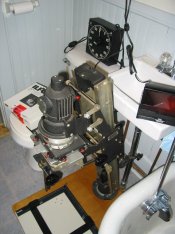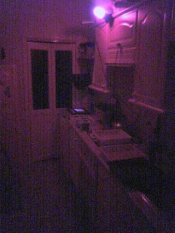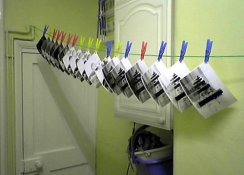Mick Fagan
Subscriber
The smallest darkroom I have ever had was the insides of a large box, which I also slept in; it was attached to a motorcycle. The box replaced the original sidecar that was damaged quite badly after some bodywork done by a tree on an off road excursion. It was a coffin shaped rectangular box with a canvas top; it carried all of my worldly possessions.
On moonless nights camped alongside a river (for water) I draped a canvas over the bike, with two poles between the bike and chair, to give elevation; I had a nice darkish set-up. My enlarger was a small fold down English thing which when folded up, resembled a very small suitcase, the baseboard was one side of the case, I was only using 5x7 paper.
Power was from the bike battery; I had a 6-volt globe in the enlarger, as the bike was a 6-volt system. The safelight was a hurricane lamp with some ruby on a wire frame surrounding it. I could use the battery until it almost went flat as the bike had a magneto system for the ignition. I used a super cheap alarm clock with two bells on it's top, as a timer. It didn't have a second hand, but the ticks were really loud.
I developed in 3, 5x7 Ilford dishes, which I still have. Washing was done in a saucepan picked up from the side of the road, it had no handle.
This was in the late sixties, I still have a few prints, the quality is terrible, but they are pictures that have great memories.
On the road one day, I met up with a couple travelling in a Kombi camper. They had a really good darkroom that packed away in one very small cupboard, which I think was originally a small wardrobe. They were using the same enlarger as I was.
Another time in the mid to late seventies I met a couple of photographers travelling for about 3 months at a time and they used a small lean to tent, as a darkroom on moonless nights as well. I met them again in the early eighties, in the far north of Australia; they were camped alongside a river and were processing E6 films.
One of the really inspirational things I saw them doing, was the heating of the E6 developer in jam jars, by using magnifying glasses focused onto a small piece of steel sitting inside the developer. As the ambient temperature never got below about 24C overnight in the dry season, the solution was already reasonably warm to start with.
I have used wardrobes a lot for darkrooms; they get hot and humid quickly. Many a bathroom has been converted by using three pieces of timber running the length of the bath, on this I hold the dishes, which ran in a row behind the enlarger. Usually the basin is used for washing the prints.
All of my lady friends usually complained about the bathroom being dominated by the photographic equipment, one didnt, she is now my wife!
Mick.
On moonless nights camped alongside a river (for water) I draped a canvas over the bike, with two poles between the bike and chair, to give elevation; I had a nice darkish set-up. My enlarger was a small fold down English thing which when folded up, resembled a very small suitcase, the baseboard was one side of the case, I was only using 5x7 paper.
Power was from the bike battery; I had a 6-volt globe in the enlarger, as the bike was a 6-volt system. The safelight was a hurricane lamp with some ruby on a wire frame surrounding it. I could use the battery until it almost went flat as the bike had a magneto system for the ignition. I used a super cheap alarm clock with two bells on it's top, as a timer. It didn't have a second hand, but the ticks were really loud.
I developed in 3, 5x7 Ilford dishes, which I still have. Washing was done in a saucepan picked up from the side of the road, it had no handle.
This was in the late sixties, I still have a few prints, the quality is terrible, but they are pictures that have great memories.
On the road one day, I met up with a couple travelling in a Kombi camper. They had a really good darkroom that packed away in one very small cupboard, which I think was originally a small wardrobe. They were using the same enlarger as I was.
Another time in the mid to late seventies I met a couple of photographers travelling for about 3 months at a time and they used a small lean to tent, as a darkroom on moonless nights as well. I met them again in the early eighties, in the far north of Australia; they were camped alongside a river and were processing E6 films.
One of the really inspirational things I saw them doing, was the heating of the E6 developer in jam jars, by using magnifying glasses focused onto a small piece of steel sitting inside the developer. As the ambient temperature never got below about 24C overnight in the dry season, the solution was already reasonably warm to start with.
I have used wardrobes a lot for darkrooms; they get hot and humid quickly. Many a bathroom has been converted by using three pieces of timber running the length of the bath, on this I hold the dishes, which ran in a row behind the enlarger. Usually the basin is used for washing the prints.
All of my lady friends usually complained about the bathroom being dominated by the photographic equipment, one didnt, she is now my wife!
Mick.






















